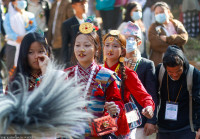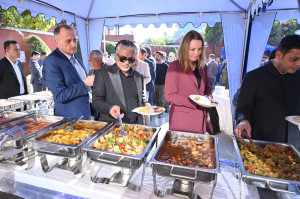Culture & Lifestyle
One man’s mission to clean Kathmandu’s forsaken heritage
Yaddhab Lal Kayastha started a campaign almost three years ago to restore cultural sites. Today, he’s covered over 100 sites in the Kathmandu valley.
Shashwat Pant
On a recent hot afternoon, Yaddhab Lal Kayastha gathered with a few others at Jagati in Suryabinayak, Bhaktapur. The heat was cruel, sweat dripped down their temples but the small group were assembled for a purpose: to restore and clean an old hiti (a stone sprout) and a falcha (a resting place) that have been left uncared for for a long time.
“We got a call from the locals who told us that there were plans to demolish them entirely in the name of road expansion. I couldn't let that happen,” says the 39-year-old Kayastha.
They thus started cleaning and restoration works a week ago and have finished almost 90 percent of work. They have carried out this job with little to no financial assistance from anyone and by working with locals from the area.
“We just want to show that restoring or saving these archeological sites is not hard. All you need is the will to work and some like-minded people,” says Kaystha. But this isn’t the first heritage monument Kayastha has helped restore and he hopes it isn’t going to be the last.
Kayastha is the leader of a campaign called Sampada Bachau Mahaabhiyan that he started two and half years ago, out of sheer love for cultural heritage. And in just two and a half short years, Kayastha says the campaign has restored over a 100 such sites, which include temples, ponds, hitis and falchas.
“We are just a group of people who love heritage. We get notified about such monuments from locals after which we work with them to restore it. It's very simple,” says Kayastha, who previously served in the Nepal Army. After retiring from the army, Kayastha opened a restaurant in Chhetrapati, where he met a lot of tourists with whom he talked about how Nepal was rich in cultural heritage. But one day, when he joined some tourists for a walk around the neighbourhood, he was quite shocked to see the state of some sites. And this didn’t sit well with him.
“We boast a lot about how rich we are when it comes to culture and heritage. But when you go and visit these spaces, the picture is different. Many of these sites are in a sorry state and no one has been doing anything about it,” says Kayastha, referring to sites that do not fall under the government’s radar and are often forgotten by authorities.
That is when he decided to stop waiting around for authorities to do their job and do what he could as a responsible citizen. The first site he cleaned and restored was the Bhotupale hiti in Sorakhutte, which had been in a sorry state for as long as he can remember.
“I always felt sad seeing the hiti like that. As a person who is from the area, that made me very sad. So, I talked to locals and asked some friends and just got to work,” he says.
And just like that the campaign started. He visited the site, then he talked to the locals involved with the site because he believes the local people have a better idea about their local heritage than any government body. “There are over 1,000 hitis in Kathmandu valley alone. But the Department of Archeology only has a record of around 500. So before going to the government body, I go to the locals who have a better idea of what is in their locality,” he says.
He documented the entire restoration process and posted a video of it on social media which created a lot of traction on social media. People started to join Kayastha and even more started to message him about sites that needed saving across the Valley, he says.
“When people started calling me requesting me to come and look at the site in their localities that made me really happy. I felt that I was going in the right direction,” says Kayastha, who works with different people with every project
Even though there are no government-associated specialists working with him in the restoration process, there are a lot of elderly local people in the group who know about Nepali heritage, with whom he is in constant contact in the entire duration of the restoration project, says Kayastha. “We work in close coordination with them because we don’t want to cause any harm to the archaeological site,” he says.
However, doing all this hasn’t been smooth sailing for Kayastha or the campaign. He says they have faced a lot of challenges including threats and bribes.
“The people who want to bury these monuments to construct high rise buildings are the ones who have caused us the most problems. They use their political affiliations to stop us from doing what we do. People have come up to me and told me they’d give me money if I stopped doing what I do,” says Kayastha.
But nothing has slowed him or the campaign down yet because he says they are doing it within law and adds that no one who is involved is in it for monetary gain. “We do things in the most economical way,” he says. “What we need is man power more than money. If you look at our previous work, you’ll notice that the only time we need money is to have food.”
Even that comes from the community sometimes, he says. “People when they see us working to clean or restore a site in their area, they offer to help in whatever ways they can. From offering manpower to tea. Every little has helped so far,” says Kayastha.
And this selfless work is also being appreciated by the local governments. After seeing the work Kayastha and his team did with the hiti and falcha in Jagati, the ward chair of Suryabinayak–9 has announced that he will help the campaign. “When you have a ward chair come and applaud us for the work we are doing, you know that you’re going in the right direction,” he says.
When asked what he thinks about the response he’s been getting, Kayastha says that it drives him to work even harder. “I’m aware that people are watching me. And I don’t want to let them down,” he says.




 19.12°C Kathmandu
19.12°C Kathmandu













%20(1).jpg&w=300&height=200)

